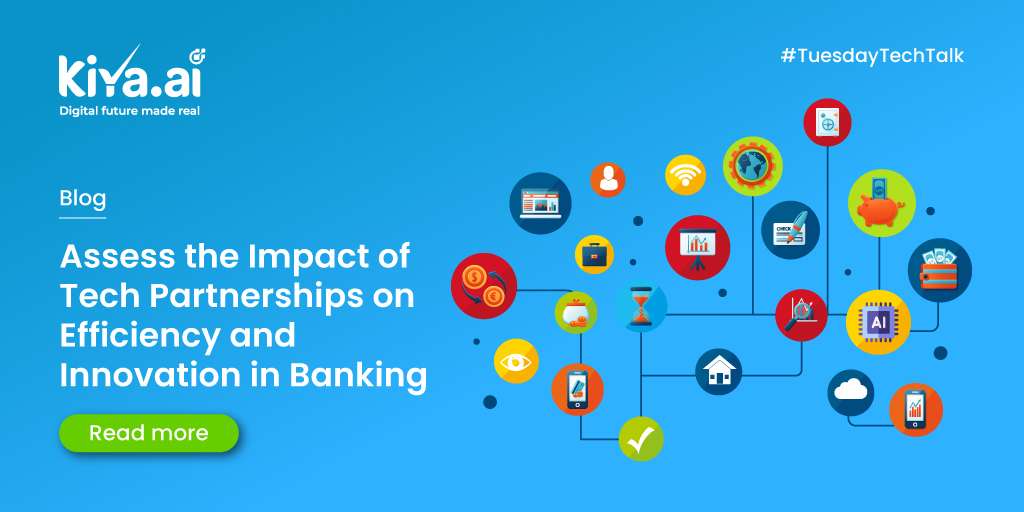Assess the Impact of Tech Partnerships on Efficiency and Innovation in Banking

As we explore the evolving financial market, understanding the entire financial ecosystem—current accounts, savings, investments, mortgages, credit, pensions, insurance, and beyond—is crucial. This broader view, known as Open Finance, empowers customers with control over their data across all financial services, paving the way for innovative solutions.
In this context, tech partnerships play a pivotal role in enhancing efficiency and driving innovation in banking. By collaborating with technology providing firms, banks can leverage digital advancements to streamline operations, improve customer experiences, and create cutting-edge financial products.
Here are some key points highlighting how banking SaaS providing firms are supporting global banks and financial institutions in thriving in the digital space:
- Enhanced Efficiency: Banking tech solutions streamline processes that were once manual and paper-based in traditional banking. Through automation and digitalisation, tasks such as account opening, transaction processing, and customer onboarding are executed swiftly, reducing turnaround times and operational costs.
- Improved Customer Experience: Digital banking offers unparallelled convenience and accessibility to customers. Fintech-driven platforms provide intuitive interfaces, personalised services, and round-the-clock support, enhancing overall satisfaction and loyalty.
- Agile Lending Platforms: Traditional lending practises often entail lengthy approval processes and stringent criteria. Digital lending solutions leverage data analytics and AI algorithms to assess creditworthiness swiftly and accurately. This enables banks to cater to a wider range of customers, including the rural areas with traditional banking systems.
- Advanced AML Approach: Combatting money laundering, fraud and financial crimes is a top priority for banks. Tech providing firms offer cutting-edge Anti-Money Laundering (AML) Solution and Anti-Fraud Solution (AFS) powered by machine learning and predictive analytics. These tools enhance risk detection capabilities, ensuring compliance with regulatory standards while minimising false positives.
- Cloud-based Core Banking: Banking tech provider companies offer robust core banking solutions that modernise legacy systems and infrastructure. Cloud-based platforms, modular architectures, and microservices enable scalability, flexibility, and rapid deployment, empowering banks to adapt to evolving market dynamics swiftly.
Partnering with the right open finance and tech providers equips banks with the agility and innovation required to thrive in the digital era. While traditional banking models have their strengths in stability and trust, digital banking offers unparallelled speed, accessibility, and customisation. By embracing correct tech partnerships, global banks can leverage the best of both worlds, combining the reliability of traditional banking with the innovation of digital solutions to deliver exceptional value to customers and stakeholders alike.
The Emerging technology Trends Shaping India’s banking Landscape
Today, India’s banking-tech landscape has seen significant advancements, driven by key industry trends that are reshaping the banking sector. Here’s how these trends are helping the industry:
- Tokenization for Enhanced Security and Efficiency: Leveraging India Stack, financial institutions are embracing tokenization to enhance security and efficiency in digital transactions. By replacing sensitive data like card numbers or bank account details with unique tokens, they ensure secure payments across various channels such as Cards, UPI, and digital wallets.
- Integration of Extended Reality (XR) into Financial Services: The future of financial services is being shaped by extended reality (XR) technologies. Industries are exploring how XR can enhance experiences, including industrial automation and enterprise solutions. This integration requires active participation from financial services to facilitate seamless transactions and experiences through a B2B2C model.
- Harnessing Generative AI: Banks are leveraging generative AI technologies to deliver personalised, efficient, and secure banking experiences. These technologies empower SMEs and global financial institutions to compete effectively with larger counterparts by maintaining operational agility and cost-effectiveness.
The partnership between banking tech firms and traditional banks is driving significant progress, both globally and in India. By teaming up, they combine the experience and regulatory expertise of traditional banks with the innovative solutions and agility of tech firms. This collaboration helps them navigate the complexities of the digital landscape, ensuring they remain competitive and relevant in today’s fast-paced financial world.
As we explore the evolving financial market, understanding the entire financial ecosystem—current accounts, savings, investments, mortgages, credit, pensions, insurance, and beyond—is crucial. This broader view, known as Open Finance, empowers customers with control over their data across all financial services, paving the way for innovative solutions.
In this context, tech partnerships play a pivotal role in enhancing efficiency and driving innovation in banking. By collaborating with technology providing firms, banks can leverage digital advancements to streamline operations, improve customer experiences, and create cutting-edge financial products.
Here are some key points highlighting how banking SaaS providing firms are supporting global banks and financial institutions in thriving in the digital space:
- Enhanced Efficiency: Banking tech solutions streamline processes that were once manual and paper-based in traditional banking. Through automation and digitalisation, tasks such as account opening, transaction processing, and customer onboarding are executed swiftly, reducing turnaround times and operational costs.
- Improved Customer Experience: Digital banking offers unparallelled convenience and accessibility to customers. Fintech-driven platforms provide intuitive interfaces, personalised services, and round-the-clock support, enhancing overall satisfaction and loyalty.
- Agile Lending Platforms: Traditional lending practises often entail lengthy approval processes and stringent criteria. Digital lending solutions leverage data analytics and AI algorithms to assess creditworthiness swiftly and accurately. This enables banks to cater to a wider range of customers, including the rural areas with traditional banking systems.
- Advanced AML Approach: Combatting money laundering, fraud and financial crimes is a top priority for banks. Tech providing firms offer cutting-edge Anti-Money Laundering (AML) Solution and Anti-Fraud Solution (AFS) powered by machine learning and predictive analytics. These tools enhance risk detection capabilities, ensuring compliance with regulatory standards while minimising false positives.
- Cloud-based Core Banking: Banking tech provider companies offer robust core banking solutions that modernise legacy systems and infrastructure. Cloud-based platforms, modular architectures, and microservices enable scalability, flexibility, and rapid deployment, empowering banks to adapt to evolving market dynamics swiftly.
Partnering with the right open finance and tech providers equips banks with the agility and innovation required to thrive in the digital era. While traditional banking models have their strengths in stability and trust, digital banking offers unparallelled speed, accessibility, and customisation. By embracing correct tech partnerships, global banks can leverage the best of both worlds, combining the reliability of traditional banking with the innovation of digital solutions to deliver exceptional value to customers and stakeholders alike.
The Emerging technology Trends Shaping India’s banking Landscape
Today, India’s banking-tech landscape has seen significant advancements, driven by key industry trends that are reshaping the banking sector. Here’s how these trends are helping the industry:
- Tokenization for Enhanced Security and Efficiency: Leveraging India Stack, financial institutions are embracing tokenization to enhance security and efficiency in digital transactions. By replacing sensitive data like card numbers or bank account details with unique tokens, they ensure secure payments across various channels such as Cards, UPI, and digital wallets.
- Integration of Extended Reality (XR) into Financial Services: The future of financial services is being shaped by extended reality (XR) technologies. Industries are exploring how XR can enhance experiences, including industrial automation and enterprise solutions. This integration requires active participation from financial services to facilitate seamless transactions and experiences through a B2B2C model.
- Harnessing Generative AI: Banks are leveraging generative AI technologies to deliver personalised, efficient, and secure banking experiences. These technologies empower SMEs and global financial institutions to compete effectively with larger counterparts by maintaining operational agility and cost-effectiveness.
The partnership between banking tech firms and traditional banks is driving significant progress, both globally and in India. By teaming up, they combine the experience and regulatory expertise of traditional banks with the innovative solutions and agility of tech firms. This collaboration helps them navigate the complexities of the digital landscape, ensuring they remain competitive and relevant in today’s fast-paced financial world.



